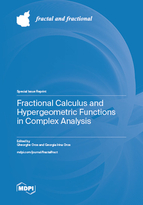Fractional Calculus and Hypergeometric Functions in Complex Analysis
A special issue of Fractal and Fractional (ISSN 2504-3110). This special issue belongs to the section "General Mathematics, Analysis".
Deadline for manuscript submissions: closed (15 March 2023) | Viewed by 25746
Special Issue Editors
Interests: special classes of univalent functions; differential subordinations and superordinations; differential operators; integral operators; differential-integral operators
Special Issues, Collections and Topics in MDPI journals
Interests: special classes of univalent functions; differential subordinations and superordinations; differential operators; integral operators; differential–integral operators
Special Issues, Collections and Topics in MDPI journals
Special Issue Information
Dear Colleagues,
Fractional calculus has had a powerful impact on recent research, having many applications in different branches of science and engineering. Various branches of mathematics are also influenced by fractional calculus. Applications in complex analysis research are comprehensive, and interesting new results have been obtained in studies involving univalent functions theory.
This Special Issue aims to gather new research outcomes combining this prolific tool with another that generates exciting results when integrated into studies: hypergeometric functions.
The study of hypergeometric functions dates back 200 years. They appear in the work of Euler, Gauss, Riemann, and Kummer. Interest in hypergeometric functions has grown in the last few decades due to hypergeometric functions’ applications in a large variety of scientific domains and many areas of mathematics. Hypergeometric functions were linked to the theory of univalent functions by L. de Branges’ proof of Bieberbach’s conjecture, published in 1985, which uses the generalized hypergeometric function. After this connection was established, hypergeometric functions was studied intensely using geometric function theory.
Quantum calculus is also involved in studies alongside fractional calculus tools and different hypergeometric functions.
Researchers interested in any of these topics or a combination of them and their applications in different areas concerning complex analysis are welcome to submit their findings and contribute to the success of this Special Issue.
Topics include but are not limited to:
- New definitions and applications in fractional calculus operators;
- Applications of fractional calculus involving hypergeometric functions in geometric function theory;
- Orthogonal polynomials, including Jacobi and their special functions, including Legendre polynomials, Chebyshev polynomials, and Gegenbauer polynomials;
- Applications of logarithmic, exponential, and trigonometric functions regarding univalent functions theory;
- Applications of gamma, beta, and digamma functions;
- Applications of fractional calculus and hypergeometric functions in differential subordinations and superordinations and their special forms of strong differential subordination and superordination and fuzzy differential subordination and superordination;
- Applications of quantum calculus involving fractional calculus in geometric function theory;
- Applications of quantum calculus involving hypergeometric functions in complex analysis.
Prof. Dr. Gheorghe Oros
Dr. Georgia Irina Oros
Guest Editors
Manuscript Submission Information
Manuscripts should be submitted online at www.mdpi.com by registering and logging in to this website. Once you are registered, click here to go to the submission form. Manuscripts can be submitted until the deadline. All submissions that pass pre-check are peer-reviewed. Accepted papers will be published continuously in the journal (as soon as accepted) and will be listed together on the special issue website. Research articles, review articles as well as short communications are invited. For planned papers, a title and short abstract (about 100 words) can be sent to the Editorial Office for announcement on this website.
Submitted manuscripts should not have been published previously, nor be under consideration for publication elsewhere (except conference proceedings papers). All manuscripts are thoroughly refereed through a single-blind peer-review process. A guide for authors and other relevant information for submission of manuscripts is available on the Instructions for Authors page. Fractal and Fractional is an international peer-reviewed open access monthly journal published by MDPI.
Please visit the Instructions for Authors page before submitting a manuscript. The Article Processing Charge (APC) for publication in this open access journal is 2700 CHF (Swiss Francs). Submitted papers should be well formatted and use good English. Authors may use MDPI's English editing service prior to publication or during author revisions.
Keywords
- univalent functions
- special functions
- fractional operators
- differential subordination
- differential superordination
- quantum calculus
Benefits of Publishing in a Special Issue
- Ease of navigation: Grouping papers by topic helps scholars navigate broad scope journals more efficiently.
- Greater discoverability: Special Issues support the reach and impact of scientific research. Articles in Special Issues are more discoverable and cited more frequently.
- Expansion of research network: Special Issues facilitate connections among authors, fostering scientific collaborations.
- External promotion: Articles in Special Issues are often promoted through the journal's social media, increasing their visibility.
- e-Book format: Special Issues with more than 10 articles can be published as dedicated e-books, ensuring wide and rapid dissemination.
Further information on MDPI's Special Issue policies can be found here.







